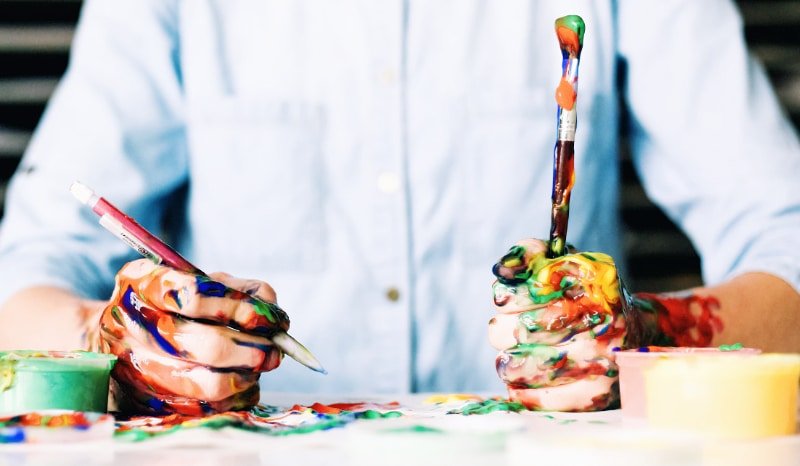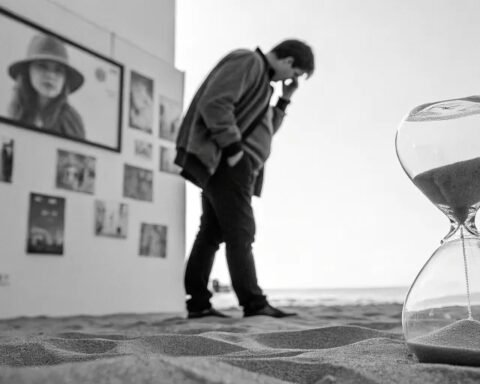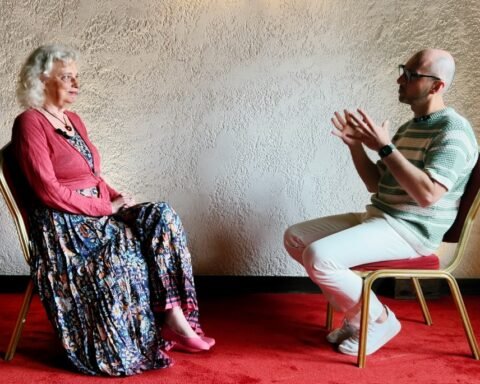In 2017, I was diagnosed with breast cancer. All the emotions, existential questions, and fears I write about in my article were experienced, lived through and comprehended by me in my own psychotherapy during oncological disease treatment. During my treatment, I noticed how important it is for cancer patients to be accompanied by a psychotherapist for successful cancer treatment or long-term remission. The patients I met in the queue in the hospital who were visiting psychotherapists were distinguished by confidence and calmness from those who underwent treatment for the disease alone. In private conversations, oncologists spoke about the psychological factor, called it the mood for treatment, and noted its importance.
In 2018, after completing my cancer treatment, I organized a cancer patient support group. The main motive was supporting patients during treatment, sharing patient experiences, and helping. The number of people in the support group increased yearly; society required an official status and knowledge of psychology for me. I received psychological training in the existential approach and continue to improve my educational level in Gestalt therapy. Already, from the point of view of a professional, I was interested in the methodological substantiation of the psychotherapeutic methods used and the clarification of the specifics of psychotherapy for oncological patients.
Creative workshops began to be held in our society in 2021 as one of the rehabilitation methods to reduce stress and anxiety for cancer patients undergoing treatment and those in remission. In this article, I reflect on the results of conducting creative workshops in our society and study the experience of running art therapy for cancer patients in the psychotherapeutic community.
The primary mental disorders in cancer patients are distress, depression and anxiety ( Schiltz, Zimoch, 2017; Belay et al., 2022; Yang, 2014). These disorders negatively affect the feelings, emotions, knowledge of the world around them, people’s behaviour and physical condition ( Association AP, 2013), reducing overall quality of life. In turn, quality of life (QOL) is one of the crucial indicators reported by patients during therapy ( B . Sc . Tech JLMSTaHV, 2021) and is directly dependent on the psychological state: when psychological distress decreases, the assessment of quality of life increases ( Badger et al., 2013 ), which also has a positive effect on recovery.
Thus, one of the most essential questions in rehabilitating cancer patients is: How can psychological distress be reduced? What precisely the psychotherapeutic methods should aim at? Which one is best for this task?
Based on my experience of going through the disease and accompanying people from the mutual aid society “PAR DZīVOT”, I see that art therapy methods, used individually or in combination with other psychological methods, can be especially useful.
By art methods, I mean creative workshops that help sick people express emotions and create meanings and images. In addition to the well-known isotherapy music therapy, I suggest using any creative technique with which a finished art object is created.
Nevertheless, before substantiating the significance of the methods I describe, it is important to understand the characteristics of the psychological state and emotional experience of people undergoing cancer treatment.
A review of publications ( Tjasink, 2010; Schiltz , Zimoch, 2017; Belay, 2020, Gras et al ., 2022; Marti et al, 2023) showed that the following were identified as psychological features in cancer patients :
1) the relevance of existential issues (questions of meaning, life and death, loneliness and isolation);
2) strong accumulated emotional stress,
3) loss of control over one’s own body.
When offering rehabilitation methods and developing a particular psychological program of work with oncological patients, it is necessary to consider all three aspects. In this regard, art therapy techniques provide such an opportunity, space for imaginary and symbolic processing of experiences and comprehension of the existential questions that have arisen.
Let us consider in more detail the specifics of the experiences of a person living the experience of an oncological disease.
Emotional solid distress is caused both by the very fact of the disease and by various traumatic medical interventions. Any medical intervention in the treatment of cancer causes discomfort. There is no direct link between medical intervention and improvement. On the contrary, any medical intervention that seems to be aimed at treatment, in fact, causes various kinds of side effects that significantly reduce the quality of life and are not perceived as healing.
The encounter with cancer raises existential questions related to the fear of death and increases the anxiety associated with understanding the finiteness of one’s life. Irvin Yalom, in particular, writes about this in detail in his works. In the book “Mommy and the Meaning of Life” (2006), the author describes a woman named Paula, who came to him at the terminal stage of cancer but did not consider herself a cancer patient. “And, indeed, during the many years of wandering with her, I never once treated her as a patient,” writes Yalom, “Paula briefly told the story of her illness: five years ago, she was diagnosed with breast cancer. Then, the removal of the breast, cancer of the second breast, and the removal of the second breast. The time has come for chemotherapy with its horrendous side effects: nausea, vomiting, and hair loss. This is followed by irradiation. However, nothing could stop the development of the disease. Her cancer begged for food.
We met every week. Opposite her name, I put the word “psychotherapy”. Our roles were unclear <…> It was not an ordinary contract between a psychotherapist and a patient. I was very reluctant to touch on specific topics in her presence: money, marriage bonds, social relations, and carnal pleasures. They seemed vulgar and tasteless to me.
We discussed other things: life and death, the world, man’s superiority over other people, spirituality – this worried Paula. The four of us met every week. Precisely four: she, I, her death and mine. She became a courtesan of death: she told me about her and taught me to think about death and not fear it.
Yalom draws attention to the fact that more than death, people are afraid of loneliness, the constant companion of the disease. “We try to go through life hand in hand with someone, but we have to die alone. Paula told me that the isolation of a dying person can be of two types. The patient himself tries to separate from the living, not wanting to involve family and friends in his fears and terrible thoughts, feeling their uselessness, clumsiness and uncertainty about what to say and how to behave, trying to avoid communication, wanting to be away from the “preliminary watching your own death.”
The opportunity to go through the acute crises of life not alone is extremely valuable. Yes, many things in life are given that we cannot change, but it is up to us to choose how we will deal with them. In this regard, psychological support and rehabilitation are significant, making it possible to accommodate one’s feelings, remain in dialogue, and be seen as a person and not as a patient.
In the medical approach, when a doctor examines a sick person, relying on his experience and education, as well as intuition, he turns a person into an “object” of treatment. The physician determines the etiology, diagnosis, and appropriate course of treatment for the subject. Further, any treatment stage also transfers a sick person into an object – a “patient”. Manipulations and actions are carried out with the patient. All this creates a fundamental power imbalance. Such “objectification” should preferably be avoided when choosing an approach in the psychotherapeutic process; it may prevent or completely not contribute to the disclosure of a more complete and general understanding of oneself.
A person undergoing cancer treatment may feel valued. Moreover, both at the medical level and at the level of one’s own family and society, and, more importantly, within oneself. Often, assessment comes down to understanding one’s own failure and dissatisfaction with one’s own life attitudes and decisions. In addition, the researchers point out that the self-esteem, self-esteem of sick people due to the appearance of a threat to life in their own body often falls sharply. Cancer operates contrary to the normal process of meaning making . It is not the outer limitations of the world that suppress us, but our own body.
Many patients find their fault in the appearance of a destructive element in the body – a tumor or tumor cells. Moreover, they often associate the disease with their own emotional experience – previous experiences, strong negative emotions, resentment, insoluble life situations (insoluble from the point of view of the sick person), which often cause suicidal thoughts.
Cancer often prompts people to reevaluate their lives and reassess their priorities, values, and identity. Existential psychotherapy is well suited for this kind of work. Changes also take place in the time field of a person – the future does not look like time full of possibilities, but only like a change of monotonous days. At the same time, the main psychotherapeutic approach that is applied to cancer patients, which has an evidence base for effectiveness, is cognitive behavioral therapy. Through this therapy, affected people replace their dysfunctional beliefs with more positive ones and learn better strategies to deal with stress and anxiety. But within the framework of this therapy, it is impossible to work out the deep feelings and existential questions that arise in patients. There is no space for self-manifestation , for the living of feelings, which are so important, in the opinion of people who are in an acute crisis. There is also no possibility of integrating conscious and unconscious (repressed) experiences, which is provided by working with images through art methods.
The current lack of empirical research on the effectiveness and benefits of art therapy, both as a separate method and in complex applications with other humanistic psychotherapeutic methods, makes it difficult to actively develop and apply this area in clinical practice and support societies funded by related organizations. That is why the implementation of research projects in the future seems to be one of the priority tasks.
As one of the few studies on art therapy, we can mention the work of L. Schlitz and A. Zimoch ( Schiltz , Zimoch , 2017), where writing texts with musical accompaniment was chosen as an art therapy. There were 12 sessions, the clinical group consisted of 42 patients (16 men and 26 women). The stories written as part of the therapy were analyzed in a mixed way using an original rating scale established in a constructivist -phenomenological perspective. To analyze spontaneous comments, patients were asked to give interviews in which they expressed their subjective assessment of the sessions. The interviews were recorded and transcribed by the therapist. The analysis focused on the meaning of the therapeutic experience for the patient, based on which the following conclusions were drawn ( Schiltz , Zimoch , 2017):
• Art therapy can become a valuable therapeutic tool in psycho-oncology , after the art therapy sessions, a reduction in stress, anxiety and anxiety is diagnosed.
• Verbal elaboration should accompany artistic creation.
• Conducting workshops is desirable in a special therapeutic environment, since too expressive sessions outside such an environment can re-traumatize the patient.
• Art psychotherapy should continue for a long time, as it is noted that there are three critical moments in the psychotherapeutic support of a cancer patient – at the time of diagnosis, after the end of intensive treatment and in case of relapse, and each stage requires psychotherapeutic support.
Also in the work of M. Tyasink ( Tjasink , 2010) described sessions (ranging from 1 to 12) in which psychotherapist’s clients drew images that appeared to them during the session. In a subsequent conversation with a psychotherapist, they interpreted the drawn images and discussed the emerging meanings. As a result of the analysis of the conduct of such art therapy sessions, the following conclusions were made:
• Art psychotherapy develops the ability to imagine and symbolically work through the conflicts and tensions of everyday life, which leads to overcoming stress and anxiety.
• Art therapy provides an accepting space where you can feel heard, without judgment or criticism, there are no judgments or correct answers.
• In clearing up traces of prior traumas, art therapy is less intrusive than any verbal psychotherapy because past traumas work indirectly through artistic creations before being consciously worked through and integrated.
• Art therapy allows you to switch attention from the hospital routine to human individuality. The hospital routine is entirely connected with bodily manifestations, but does not consider a person as a complex integral unit. With the help of art therapy, the connection of the body, mind, emotions returns to a person.
• Art therapy allows you to regain a sense of control and control over your own body, which gives additional energy and self-confidence.
• Art therapy can support this debriefing process and provide people with the opportunity to reassess their values and identities and make changes that may have been long overdue.
In a study by Marti and colleagues ( Marti et al ., 2023) patients were given music therapy sessions lasting from 15 to 60 minutes. This study compared the effect of music therapy on patients’ mood before and after a session using the NRC questionnaire . Mean scores for anxiety, sadness, and physical discomfort show that three parameters changed significantly, indicating that the art therapy sessions effectively improved patients’ emotional state and physical discomfort during the sessions. Music therapy has been found to reduce distress and improve mood in cancer patients, which positively affects their assessment of quality of life.
In the charitable society of mutual assistance of oncological patients “PAR DZĪVOT” (“FOR LIFE”, Riga, Latvia), one of the elements of the rehabilitation program of psychological support was tested holding creative master classes. The format of the master classes was not standard and was determined based on the physical and emotional state of the majority of cancer patients undergoing treatment. In accordance with the tasks set, different types of creativity were combined and adapted, physical changes and emotional and psychological changes were evaluated after each type of creative activity.
The formats were selected taking into account the side effects of ongoing medical manipulations (surgery, chemotherapy and radiation therapy), which affected the physical and emotional state of cancer patients, including certain restrictions. At support group meetings, most participants noted the following side effects in their physical condition: the presence of unusual weakness, increased fatigue, neuropathy , lack of energy, and cognitive decline (concentration and memory). Their emotional state was defined as anxious, slightly depressive. Psychological difficulties were called – fatigue from treatment, lack of confidence in their coping abilities, loss of control over their lives, doubts about the results of treatment, fear of death. Taking into account all the factors, an easy format of various creative workshops was chosen, as unlike any kind of medical “therapy”.
In the course of testing different types of creativity, conducting creative master classes, the following aspects can be distinguished that must be taken into account in planning and organizing such rehabilitation classes:
• Classes are comfortable when they are as different as possible from any medical “therapies” that are in medical institutions. This is due to the fatigue from the duration of the treatment and the rejection of anything that resembles a hospital setting or research. As a rule, the treatment of cancer takes from several months (in the initial stages) to lifelong therapy (in the final stage), so visits to hospitals occur quite often. In addition, almost any hospital manipulation is quite unpleasant, and the similarity to actions or conditions resembling a medical approach immediately causes rejection.
• Classes should not be long in time. The entire cycle of creating an object of creativity should be within two hours, since the physical condition does not allow for a long time to sit and / or concentrate on one type of activity.
• The room should be comfortable and ventilated, as one of the side effects of chemotherapy can be a feeling of hot flashes, bradycardia, or fever.
• It is important to provide an opportunity to go to the toilet, drink water, and have a snack. This is also associated with physical side effects – dry mucous membranes, thirst, strong hunger, problems with urination and bowel movements.
• In the process of the act of creativity, a finished aesthetically pleasing work should be obtained.
• The process of cancer treatment is often associated with a sense of uncertainty, this is due to the lack of a 100% positive result of any stages of treatment, there is always a sufficient percentage probability that the therapy will not lead to a cure and remission (for patients with initial stages) or stabilization of a condition suitable for later life (for patients with end-stage disease). Therefore, the completion of work gives a feeling of control over your body and your ability to concentrate, the ability to complete processes.
• When planning a complex of rehabilitation workshops, taking into account the appearance of various degrees of neuropathy in cancer patients and the consequences of surgical intervention, it is advisable to try out different types of creativity, use different materials and textures. Such different types of activities help build new neural connections, train brain activity, carry out not medical, but creative rehabilitation of hands, fingertips, stimulate the return of control and dexterity to them. For example, in the practice of conducting creative workshops, clay, paints, felt-tip pens, sewing with a needle and fabric of different textures, glue and paper were used.
• When choosing working materials, it is necessary to take into account the increased allergenicity of patients during treatment, so materials that can cause allergic reactions should be avoided.
• When organizing a master class, even in such a format when work is required on a model or a specific topic, it is important to ensure the choice of colors, decoration elements, in order to make it possible to maximally individualize the appearance of the finished work of art.
• When working in creative workshops, the participation of a master in technique or a variant of creativity and an accompanying moderator (psychologist) is desirable. The master is responsible for the technological side of the process, the psychologist moderates the direction of the conversation, sheds light on the meaning of the master class, moderates involvement, working through difficulties, encourages reflection, and interprets the results of the work together with the participants.
In the practice of work for 2022, 21 different creative master classes were held. The most successful in terms of emotional involvement and response, as well as rehabilitation benefits (according to the feedback and reflections of those participating in creative workshops) were the following: work with clay; painting stones in pillbox technology ; creation of bouquets of flowers and fruits; sewing of textile products; neurographics ; art therapy; music therapy. I would like to note that the society « Par Dzīvot » mainly women are involved, in most cases, with breast cancer in the diagnosis. This composition is due to the number of cases of breast cancer in the population and the willingness of women to participate in patient organizations. Members of society are people who are at different stages of the disease and different stages of treatment.
Identified positive effects:
• At the initial stages of treatment, “beginners” see positive examples of adaptation to the treatment process, acceptance of the fact of the disease, physical sensations in the body, they are inspired by examples of remission and the end of therapy. In turn, those who have gone through the initial stages of treatment feel useful, realizing that their experience is significant for “newcomers”.
• Aesthetic pleasure, joy from the created object of creativity helps to counteract painful interventions and aspects of the disease.
• Any kind of art is seen as a way to switch the focus of attention from pain and illness, from anxiety and overthinking about illness in the process of treatment.
• In the process of creativity, there is an exploration of oneself and the acceptance of one’s new body and possibilities. Increased confidence in their own abilities, in the ability to control and manage their new body and the creative process.
• A new self-identity of a creative subject is born, a new person with new opportunities and emotional experiences.
• In the process of creativity, there is an expression of emotions that are difficult to express in verbal psychotherapy, a combination of the rational and the irrational, the conscious and the repressed.
• There are no evaluations in the process of creativity, and this allows you to shift the focus of attention from comparing yourself and other people (often occurring in everyday life) to a non-judgmental perception and value of the subjective.
• The creation of a finished object of art shows the ability to manage both the situation and successfully complete the case, which increases self-esteem and returns to the existential space “here and now”. The feeling of anxiety, physical pain in the body decreased according to the subjective assessments of those involved in the creative process.
Thus, both in my individual experience and in the experience of joint work of a charitable society, as well as in previous studies and literature, there is a positive effect of art therapy techniques on the psycho-emotional state of an oncological patient, reducing distress, anxiety, and overall quality of life . Art therapy, as one of the tools of psychotherapy, is recommended in combination with other psychotherapeutic methods, however, it is important to support its development from psychotherapeutic and related organisations, which will allow its wider use and implementation in the programs of psychological rehabilitation of people faced with oncology.
About author
Yulia Shkaraput , a psychologist with an existential approach specialising in working with groups, onco-consultant, founder of the cancer patient charity “PAR DZīVOT” (Riga, Latvia).
References:
Association AP (2013). Diagnostic and manual of mental disorders (DSM-5®): American Psychiatric Pub.
B.Sc.Tech JLMSTaHV (2021). Patient-reported outcome measures in cancer care: a review of the scientific evidence.
Badger, T.A., Segrin , C., Hepworth, J.T., Pasvogel , A., Weihs , K., Lopez, A.M., (2013). Telephone-delivered health education and interpersonal counseling improve the quality of life for Latinas with breast cancer and their supportive partners. Psychooncology 22(5):1035–1042
Belay, W., Kaba , M. , Labisso , W. L., Tigeneh , W., Sahile , Z., Zergaw , A., Ejigu , A., Baheretibeb , Y., Gufue , ZH, Haileselassie , W. (2022). The effect of interpersonal psychotherapy on quality of life among breast cancer patients with common mental health disorder: a randomized control trial at Tikur Anbessa Specialized Hospital// Supportive Care in Cancer.
Gras, M., Daguenet , E., Brosse , C., Beneton , A., Morisson , S. (2020). Art Therapy Sessions for Cancer Patients: A Single-Centre Experience. Oncology 2020;98(4):216-221.
Marti, P. , Fontanals , I., Canaletas , C., Sierra, J., Rodés , M., Mercadal-Brotons , M., González, I., Novelli , S. (2023). Effect of Music Therapy Treatment on Hospitalized Onco-Hematological Patients’ Anxiety, Sadness, Physical Discomfort, Mood and Quality of Life//Research Square.
Schiltz , L., Zimoch , A. (2017). Using arts psychotherapy in psycho-oncology as a means of coping with stress and anxiety. Archives of Psychiatry and Psychotherapy.
Tjasink , M. (2010). Art psychotherapy in medical oncology: A search for meaning//International Journal of Art Therapy.
Yalom, I.D. (2006) Mommy and the meaning of life . Psychotherapeutic stories. Publisher: Eksmo
Yang, YL (2014). Prevalence and associated positive psychological variables of depression and anxiety among Chinese cervical cancer patients: a cross-sectional study. PloS one 9(4).









